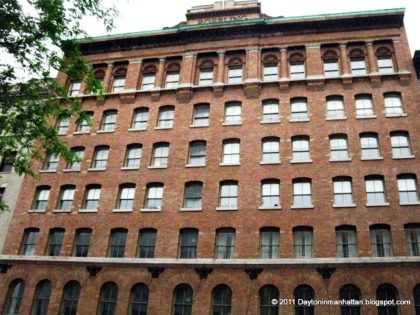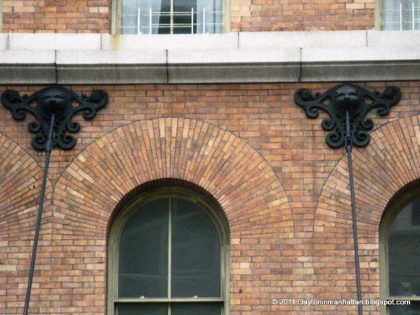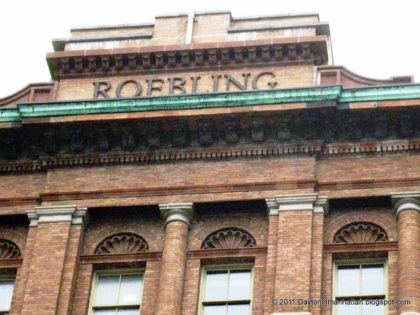The History of 169-175 Hudson
 Tom Miller, who writes about the history of Manhattan buildings at Daytonian in Manhattan, has allowed Tribeca Citizen to create a database of his Tribeca posts. If you enjoy these, and you will, then you should definitely check out his website, which also has write-ups about buildings all over the island. And don’t miss his book, Seeking New York: The Stories Behind the Historic Architecture of Manhattan—One Building at a Time.
Tom Miller, who writes about the history of Manhattan buildings at Daytonian in Manhattan, has allowed Tribeca Citizen to create a database of his Tribeca posts. If you enjoy these, and you will, then you should definitely check out his website, which also has write-ups about buildings all over the island. And don’t miss his book, Seeking New York: The Stories Behind the Historic Architecture of Manhattan—One Building at a Time.
··································
 Until two years after the end of the Civil War, St. John’s Park was the most elegant residential neighborhood in Manhattan. Refined Federal-style mansions and the beautiful Georgian-style St. John’s Chapel overlooked the idyllic park. But then Trinity Church, owner of the land, sold the park to the Hudson River Railroad Company which replaced the park with a freight terminal.
Until two years after the end of the Civil War, St. John’s Park was the most elegant residential neighborhood in Manhattan. Refined Federal-style mansions and the beautiful Georgian-style St. John’s Chapel overlooked the idyllic park. But then Trinity Church, owner of the land, sold the park to the Hudson River Railroad Company which replaced the park with a freight terminal.
And there went the neighborhood.
By the approach of the turn of the century the mansions had been demolished or converted for commercial use—mostly storehouses that took advantage of the convenient location near the freight yard. In 1893, John H. Wray joined in the development.
That year American Architect and Architecture announced plans for “two 7-story brick stores” with tin roofs that would replace the four houses at Nos. 169 through 175 Hudson Street. Wray commissioned architect James Edward Ware to design his warehouses, which would cost him $80,000. Wray’s choice was probably spurred in part by Ware’s reputation as a designer of “fireproof” warehouses.
Although Ware was given the task of designing two decidedly utilitarian structures, he produced a handsome building (it was meant to appear as one) of buff-colored iron spot brick with terra cotta trim. The arched windows of the second floor were created by intricate brickwork below a carved granite cornice. At the top floor, terra cotta shells above the windows created the illusion of an arcade. Attached brick columns and pilasters were capped by carved limestone capitals. Leafy, closely-packed brackets which upheld the cornice were replicated on the parapet above.
 Intricate brickwork creates the arched windows and cast iron beasts uphold the iron freight awning with their mouths.
Intricate brickwork creates the arched windows and cast iron beasts uphold the iron freight awning with their mouths.
··································
Wray’s investment paid off quickly. Upon completion his warehouse had a tax valuation of $46,000. A year later that figure was raised to $90,000.
Among the first tenants in the building was Leopold Schepp, a coconut importer. Schepp found himself in the middle of an international incident when his ship, the George W. Whitford, was seized by a Colombian warship. The importer demanded United States government intervention, telling The New York Times that he wanted “the annoyance and interference with our vessels’ movements, in order to drive us off the coast, [to] be stopped at once.”
Secretary of State Olney got personally involved, and the U.S. Consul at Colon obtained release of the ship and its coconuts.
Later that year James Ware’s fireproof construction would be tested when a fire broke out on September 23. The architect’s reputation was secure when little damage was done and the integrity of the structure was unscathed.
The warehouse was heavily used by the New York silk dealers and in 1899 The Spectator noted that “In the storage market there has been a lively demand for lines on raw silk, chiefly in central stores and the warehouses at 173-175 Hudson Street.”
When John Wray transferred the title to the warehouse to his wife, Eliza T. Wray on December 20, 1900, the valuation of the property had increased to $165,000. The couple was living in Laurel Hill, Long Island, at the time.
Twelve years later Eliza would sell the building, prompting The New York Times to note, “it marks the first change of ownership in the property for over sixty years.” The newspaper waxed nostalgic about the site, saying, “Diagonally opposite is the large New York Central freight depot covering what was formerly St. John’s Park and around which seventy-five years ago some of the most fashionable residences of the city were located. A few of these once-great landmarks, greatly altered into tenements or stores, may yet be seen in the neighborhood, but the commercial interest has wiped most of them out of existence.”
The buyer of the building remained unknown for a few months, until Electric World announced a few months later that it was the John A. Roebling Sons Company who would “eventually move its offices to that location.”
The Roebling firm was operated by the sons of the German-born civil engineer John Augustus Roebling who became famous for his wire rope suspension bridges, most notably the ground-breaking Brooklyn Bridge. The sons, Washington, Charles and Ferdinand, expanded their father’s wire rope manufacturing business. Their success was visibly evident when the town of Roebling, New Jersey sprang up around their company steel mill.
 Elegant terra cotta shells create the illusion of arched windows.
Elegant terra cotta shells create the illusion of arched windows.
··································
The only exterior alteration the company made to the Hudson Street warehouse was the addition of the name ROEBLING in great, bronze lettering on the parapet. The company stored and shipped its steel cables and ropes from No. 169 Hudson Street for decades. Then, as the 20th century ground to a close, the Tribeca neighborhood changed from a freight yard and warehouse district to one of trendy restaurants, shops and high-end loft residences.
In 2000 BDB Development—a partnership of Charles Dunne, Sam Waksal and Jarrett Posner—converted the warehouse into 12 luxury apartments. A 30-by-40 foot courtyard was created in the center of the building to give additional light to the interior spaces; but the architectural integrity of the original design was preserved. The iron awning over the freight docks was restored and a lost cornice reconstructed.
The immense condominium spaces—most around 4,383 square feet, with penthouse duplexes measuring 6,450 square feet—became home to well-known residents including Sean “P. Diddy” Combs; Chris Heinz, the son of socialite Teresa Heinz Kerry; and actor Waksal’s daughter Aliza.
Over a century after its construction, the Roebling Building has come a long way since it was used as storage for raw silk, coconuts and steel cables; but the handsome façade survives as a reminder of a time when commerce overtook one of New York’s loveliest neighborhoods.
··································
Photo credits: Alice Lum (3).












